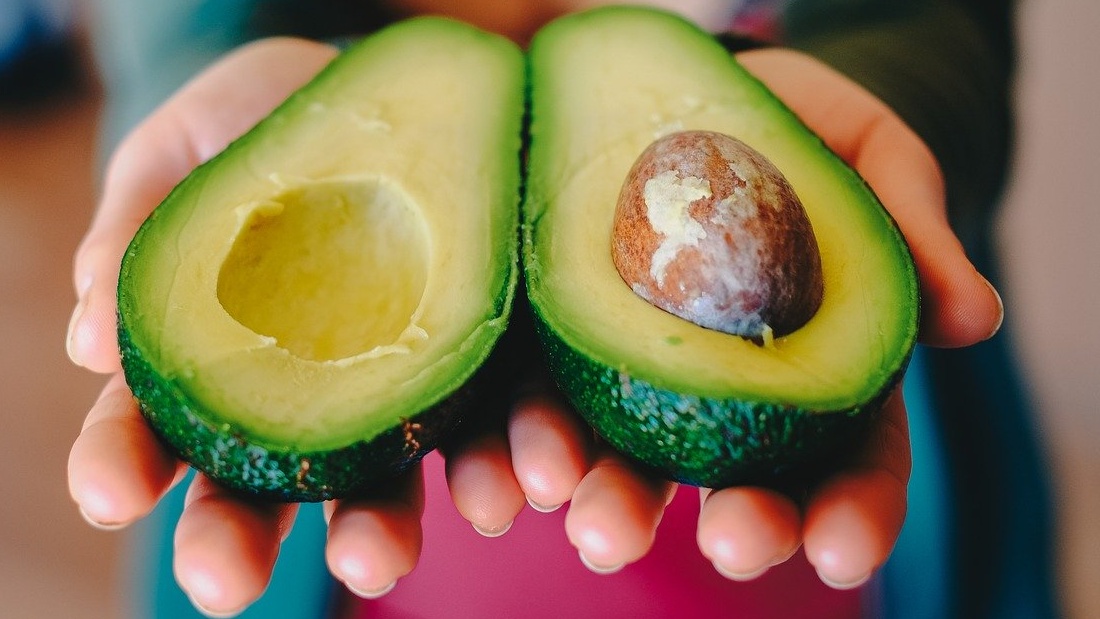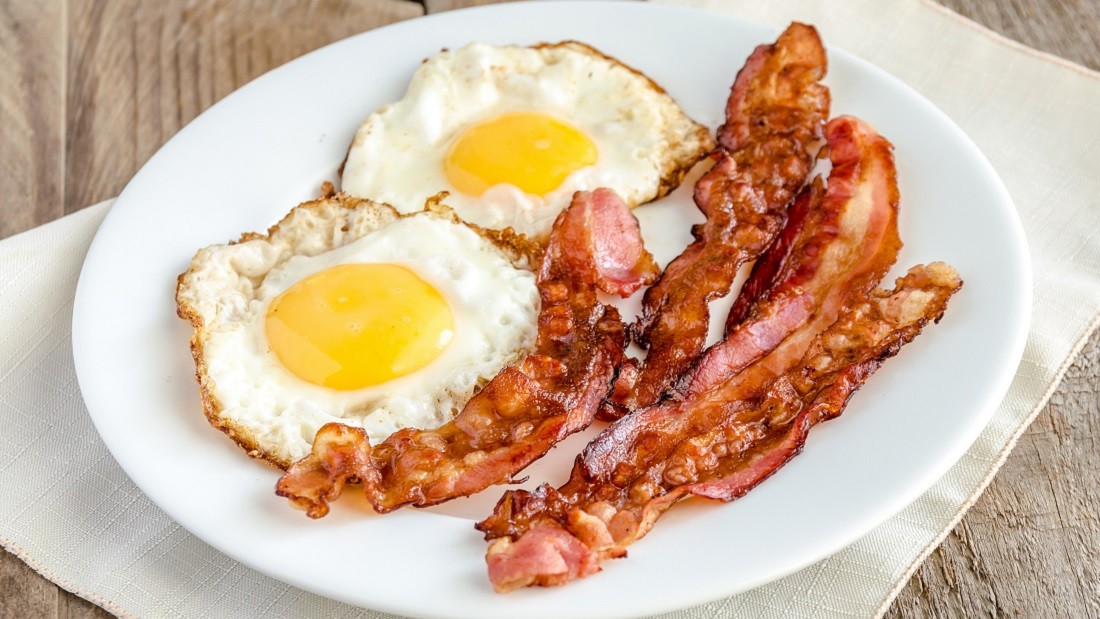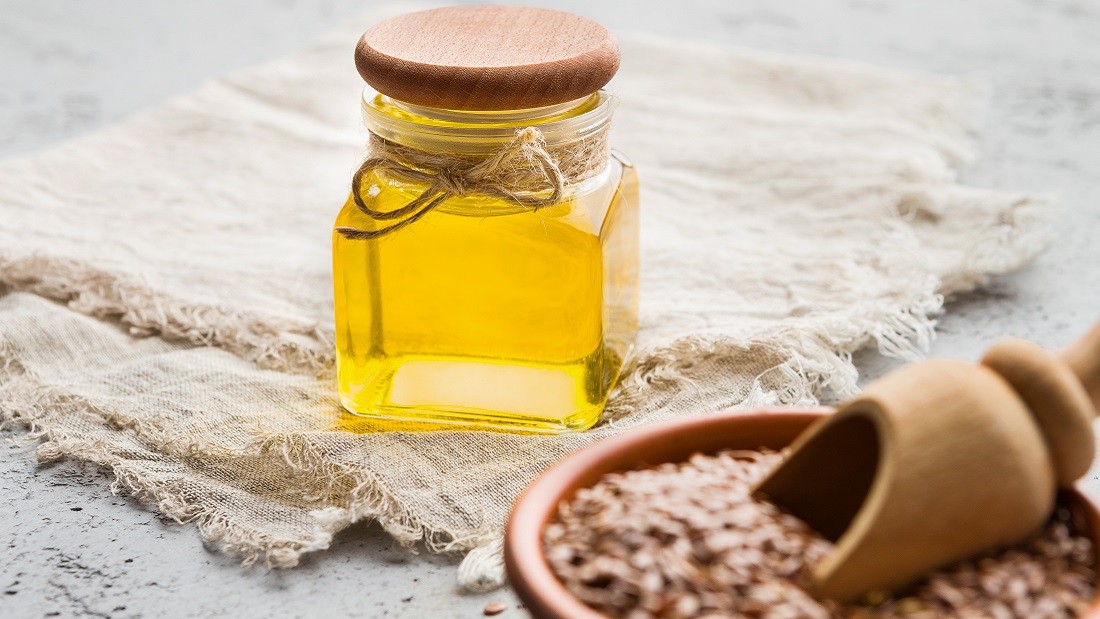Fat

How much do you need daily?
Current guidelines say that our ‘total fat’ intake should make up no more than a third (33 per cent) of our daily energy intake from food, saturated fats no more than 11 per cent, monounsaturated fats an average of 13 per cent, polyunsaturated fats 6.5 per cent and trans fats no more than two per cent.
The government recommends the following intakes
Current UK government guidelines advise cutting down on all fats and replacing saturated fat with some unsaturated fat.
- Men shouldn’t eat more than 30 grams of saturated fat a day
- Women shouldn’t eat more than 20 grams of saturated fat a day
Is your food high in fat?
| Total Fat | Saturated fat | ||
|---|---|---|---|
| HIGH FAT | more than 17.5 grams of fat per 100 grams | HIGH IN SAT FAT | more than 5 grams of saturated fat per 100 grams |
| LOW FAT | 3 grams of fat or less per 100 grams | LOW IN SAT FAT | 1.5 grams of saturated fat or less per 100 grams |
| FAT-FREE | 0.5 grams of fat or less per 100 grams | SAT FAT-FREE | 0.1 grams of saturated fat or less per 100 grams |
Are we getting enough?
The UK National Diet and Nutrition Survey found that most of us eat too much saturated fat – about 12.6 per cent of our food energy. Viva! Health recommends avoiding saturated and trans fats as much as possible, which means cutting out animal foods and limiting processed foods – you are much better off without them.
Why do we need it??
Fat is necessary for many body functions, it helps the body to absorb fat-soluble vitamins (A, D, E and K) from the diet, provides energy and insulation, protects the body’s vital organs and acts as a shock absorber.
Fat is the most energy dense of all the main nutrients. It contains more than twice as many calories (kilocalories) weight-for-weight as protein or carbohydrate. That’s why it’s a good source of energy, both for immediate use and in the storage form for use when food is scarce.
Plants tend to store their fats in seeds (such as nuts, seeds, soya beans and corn), and sometimes in the fleshy layer protecting the seed inside (eg avocados, olives and coconuts). Animals mostly store fat within their muscles (commonly called marbling fat), between their muscles, under the skin and around the organs.
Is all fat the same?
There are two categories of fat based on their chemical structure:
Saturated fat

Saturated fat is something we don’t need in the diet (there’s no recommended daily intake) as our bodies can make it. Diets high in saturated fat raise blood cholesterol levels and increase the risk of heart disease, stroke, obesity, type 2 diabetes and some cancers. Saturated fat has 10 times the cholesterol-raising power of dietary cholesterol.
The main sources of saturated fat are animal products (meat, eggs, dairy, pies, pastries, processed foods and fatty spreads), coconut oil and palm fat. Saturated fats are usually solid at room temperature.
Unsaturated fat

Unsaturated fats have at least one double bond in their chemical structure, meaning that the bond has not been saturated. Based on how many of these double bonds a fat molecule contains, it is either monounsaturated (one double bond) or polyunsaturated (more than one double bond).
Depending on their structure, polyunsaturated fats can be omega-3 or omega-6 fats. The essential fats (fatty acids) we need in our diet are both from the polyunsaturated group:
- Linoleic acid (LA) – omega-6 fat: found in seeds, nuts, corn, soya oils etc and can be converted into other important omega-6 fatty acids in the body
- Alpha-linolenic acid (ALA) – omega-3 fat: can be obtained from flaxseed/linseed – (this is the richest source by far), walnuts, hempseed, rapeseed oil, soya beans and green leafy vegetables (although vegetables are generally very low in fat so the amount of omega-3 fats in leafy vegetables is small)
The body converts ALA from the diet to other omega-3 fats – EPA and DHA – which are required for healthy brain function. These can also be obtained directly from some species of algae and some companies sell vegan, algae-based omega-3 supplements.

In the UK, there are no specific recommendations for omega-6 and omega-3 fats but the World Health Organisation (WHO) says our goal for omega-6s should be 5-8 per cent of our energy intake and 1-2 per cent for omega-3s.
WHO recommendations for daily fat intake:
| Type of fat | Percentage of total energy | Grams required for women (aged 19-50) consuming 2,000 calories per day | Grams required for men (aged 19-50) consuming 2,500 calories per day |
|---|---|---|---|
| Total fat | 15-30 | 33.3-66.7 | 41.7-83.3 |
| Saturated fat | Less than 10 | Less than 20 | Less than 25 |
| Polyunsaturated fats | 6-10 | 13.3-20.0 | 16.7-25.0 |
| Omega-6 | 5-8 | 11.1-17.8 | 13.9-22.2 |
| Omega-3 | 1-2 | 2.0-4.4 | 2.5-5.5 |
Apart from the main types of fat described above, there are also trans-fats and cholesterol – the villains we’re often warned against:
Trans-fats
Trans-fats (also called trans fatty acids and hydrogenated fats) are usually found in foods in small amounts but they are very harmful and we don’t need them at all. Trans-fats increase the risk of heart disease and stroke by raising harmful cholesterol levels. Their effect on cholesterol is twice that of saturated fats.
Low levels of trans-fats are found naturally in dairy products, lamb and beef fat. Larger amounts of trans-fats can often be found in processed foods. An industrial process known as hydrogenation is sometimes used to convert liquid vegetable oils into solid or semi-solid fats. The final product of this process is called hydrogenated vegetable oil or hydrogenated fat – which is essentially just a different term for trans-fats. It is used in some biscuits, cakes, pastry, shortening and many processed foods. By avoiding products containing hydrogenated fats or trans-fats (which always have to be declared in the ingredients), a plant-based diet can be kept healthy.
Less than two per cent of calories (but preferably none) should come from trans fats.
Note on margarine: margarine used to contain hydrogenated fats and that’s why it gained a bad reputation but most manufacturers have now moved to healthier margarine production so the quality of the products has improved (always check the ingredients though).
Cholesterol
Cholesterol is a soft, waxy substance found in the bloodstream and in all the body’s cells. It is used as a component of cell membranes and in some hormones. However, a high level of cholesterol in the blood is a major risk factor for heart disease.
Cholesterol comes from two main sources. The human body produces its own cholesterol according to its needs. Animals also naturally produce cholesterol, hence animal products contain it too. High levels may be found in egg yolks, meat, poultry, shellfish and dairy products. On the other hand, plant-based foods (every type of fruit and vegetable, pulses – peas, beans and lentils, wholegrains, nuts and seeds) are all completely cholesterol-free. So a vegan diet contain no cholesterol whatsoever.
Humans have no need for dietary cholesterol as the body can manufacture all that it requires.
Cholesterol and other fats have to be transported to and from the cells by special carriers called lipoproteins. Two types of lipoprotein are often mentioned in connection with cholesterol: low-density lipoprotein (LDL) and high-density lipoprotein (HDL).
Too much LDL in the blood can lead to the build-up of fatty deposits (plaques) on the inside walls of the arteries. Plaques can clog the arteries feeding the heart and brain (atherosclerosis), so LDL is termed ‘bad’ cholesterol. High intakes of cholesterol, saturated and trans-fats in the diet increase this harmful LDL ‘bad’ cholesterol and their consumption is therefore discouraged.
HDL, on the other hand, tends to carry cholesterol away from the arteries and back to the liver, where it is eliminated from the body. A high HDL level seems to protect against heart disease, so HDL cholesterol is termed ‘good’ cholesterol.
Generally speaking, high cholesterol levels usually refer to the bad cholesterol increasing the risk of heart disease and stroke. Cholesterol numbers are used to calculate your risk of heart disease.
Know your numbers:
| Type of cholesterol | Recommend levels (mmol/L) |
|---|---|
| Total cholesterol | 5 or less |
| LDL (low density lipoprotein cholesterol), also called ‘bad’ cholesterol | 3 or less |
| HDL (high density lipoprotein cholesterol, also called ‘good’ cholesterol) | 1 or more |
| Triglyceride | Under 1.7 |
| TC:HDL ratio (the ratio of total cholesterol divided by HDL) | Below 4 |
The average total cholesterol level in the UK is around 5.5 mmol/l for men and 5.6 mmol/l for women. People with higher risks, such as those with diabetes, heart disease or high blood pressure, will be set lower targets
For more information see:
Viva! Health’s fact sheet on fat.
An article on what’s behind the conflicting media information on saturated fats and butter.
A special feature on coconut oil.
Viva! Health materials on omega-3 fats.
Do I need a supplement?
You should be able to get all the omega-3 fats you need from eating a healthy vegan diet including ground flaxseed (linseed) or hempseed and their oils for cold food, rapeseed oil for cooking and some nuts (especially walnuts) and seeds as a healthy addition to meals.
Fish obtain omega-3s from eating plankton, algae and other fish (that have eaten plankton and algae), which are wild foods naturally rich in omega-3s. While some algae produce only DHA, recently discovered species contain both EPA and DHA. So, if you’re concerned about these long-chain omega-3s, fear not, you can obtain both from algae. Supplements are available online.
Algae for omega-3 supplements is usually grown in controlled conditions away from the sea so it doesn’t impact on marine ecosystems or deprive fish of their natural food. When fish stocks are declining so rapidly it is highly irresponsible to continue pushing them as the best source of omega-3s. Alternatives must be found and algae and other plant sources are the obvious choice. The bonus is that toxin levels are virtually non-existent.
By avoiding fish and fish oils you’ll be doing yourself a favour and the environment too, whilst getting the safest, toxin-free omega-3 fats.
For more information see www.vivahealth.org.uk/fish.
The best plant sources

Most people get enough – or even too much – omega-6 at the expense of omega-3 and need to redress the balance. A sensible approach is to limit how much omega-6-rich vegetable oil you use (like sunflower oil), switching to olive oil (omega-9) for cooking, while increasing your omega-3 intake. You can obtain all the essential omega-3 fats you need by including good plant-based sources of them in your diet. Use the table below as a guide to see if you are meeting your needs.
| Omega-3 fatty acids | One daily portion is… | Grams of ALA |
|---|---|---|
| Flaxseed (linseed) oil | 2 tsp | 5.2 |
| Ground flaxseed (linseed) | 2 tbsp | 3.2 |
| Rapeseed oil | 2 tbsp | 2.0 |
| Hempseed oil | 1 tbsp | 2.2 |
| Hempseed | 2 tbsp | 2.1 |
| Walnuts | 8 halves (28 grams) | 2.5 |
Flaxseed oil is by far the best source containing around 2.7 grams of ALA per teaspoonful.
Flaxseed facts:
- The oils and fats in the ground seeds may be damaged by light or heat so keep them refrigerated
- The oil should not be used in cooking, use it on salads in dressing and dips
- Because whole flax seeds pass through your body undigested, use ground flaxseeds and flax seed oil to get the most benefit
- Ground flaxseed are excellent sprinkled on breakfast cereals or added to smoothies
If you don’t take flaxseed daily it may be worth taking a vegan omega-3 supplement (see additional info below).
Signs of deficiency
Even small amounts of essential fatty acids (EFAs) can prevent deficiency. The UK National Diet and Nutrition Survey shows that the average daily total fat intakes are close to UK recommendations. Deficiency is only seen when these important fats make up less than 1-2 per cent of your total food energy. Where deficiency does occur, it is most often seen in infants fed very poor diets.
Typical symptoms include excessive thirst, frequent urination, dry or rough skin, dry hair, dandruff, brittle nails, headaches, stomach ache, diarrhoea and constipation. Low omega-3 intake is also linked to behavioural problems such as hyperactivity-impulsivity, anxiety, temper tantrums, sleep problems and learning difficulties in some children. Low levels of DHA have been associated with a number of neurological and behavioural disorders such as depression, schizophrenia, Alzheimer’s disease and attention deficit hyperactivity disorder (ADHD).
Omega-3 fats are important for brain function and low intake may have negative effects on behaviour, learning and mood. Most people can obtain all the EFAs they require from a well-balanced plant-based diet including flaxseed oil, nuts and seeds. In most cases, dietary replenishment will usually reverse any deficiency. If you are concerned, you can buy vegan supplements of algal omega-3 (EPA and DHA) online.
Foods to include
| Food | Omega-3, ALA (grams) | Omega-6, LA (grams) |
|---|---|---|
| Oils | ||
| Flaxseed (linseed) oil, 1 teaspoon (5g) | 2.7 | 0.7 |
| Hempseed oil, 1 tablespoon (11g) | 2.2 | 6.6 |
| Walnut oil, 1 tablespoon (11g) | 1.1 | 5.8 |
| Rapeseed (canola) oil, 2 tablespoons (22g) | 2.0 | 4.1 |
| Wheat germ oil, 1½ tablespoons (16.5g) | 1.1 | 9.0 |
| Soya oil, 1½ tablespoons (16.5g) | 1.1 | 8.4 |
| Corn oil, 1½ tablespoons (16.5g) | 0.2 | 8.8 |
| Sunflower oil, 1 tablespoon (11g) | 0.0 | 7.2 |
| Flaxseeds (linseeds) ground, 2 tablespoons (14g) | 3.2 | 0.8 |
| Walnuts, 8 halves/28g | 2.5 | 10.7 |
| Hempseeds, 2 tablespoons (24g) | 2.1 | 6.7 |
| Soya beans, cooked 2-3 tablespoons (90g) | 0.5 | 4.0 |
| Edamame (cooked) medium portion (90g) | 0.3 | 1.6 |
| Tofu firm, typical portion (100g) | 0.6 | 4.3 |
| Broccoli (cooked) medium portion (85g) | 0.1 | 0.0 |
| Soya milk, 1 glass (200g) | 0.2 | 1.2 |
| Strawberries, average portion (100g) | 0.1 | 0.1 |
| Peas (frozen and cooked) large portion (100g) | 0.0 | 0.1 |
Source: USDA Food Composition Databases.
People with diarrhoea, irritable bowel syndrome, diverticulitis or inflammatory bowel disease (Crohn’s disease or ulcerative colitis) should use caution if taking flaxseed (but not flaxseed oil) due to its possible laxative effects. If you have a medical condition, or are taking other drugs or supplements you should consult a doctor or nutritional therapist before changing your diet.
Additional information
Getting the balance right
Recent changes in the diet have led to a massive rise in our intake of omega-6 fats from plant-based oils (such as sunflower oil) and most processed foods. This has increased the ratio of omega-6 to omega-3 fats in our diets by up to as much as 30 to one. The World Health Organisation (WHO) recommends trying to lower that ratio to less than 10 to one. Others suggest aiming for below six to one. This can be achieved by reducing the use of sunflower, safflower and corn oils and increasing the use of ALA-containing oils such as flaxseed and rapeseed oils. Optimising omega-3 conversion rates can help too.
Optimising conversion
ALA is known as a ‘parent’ omega-3 fat as it can be converted by the body to form the longer-chain omega-3 fats EPA and DHA. Poor diets can reduce the rate of conversion whilst a wide range of nutrients in a good diet can improve it:
| Foods that help | Food that hinder |
|---|---|
| Biotin – yeast extract, pulses (peas, beans and lentils), nuts and most vegetables Calcium – nuts, seeds (especially sesame seeds), tahini (sesame seed paste), pulses, calcium-set tofu, calcium-fortified soya milk and green leafy vegetables (not spinach) Magnesium – green leafy vegetables, pulses, wholegrains, nuts, seeds and avocados Vitamin B3 – yeast extract, peanuts, wholemeal bread, mushrooms, sesame seeds, pulses, green leafy vegetables, asparagus, sweet potatoes and carrots Vitamin B6 – bran, wholemeal flour, yeast extract, hazelnuts, bananas, peanuts, currants, garlic and most vegetables Vitamin C – widely available in fruit and vegetables especially oranges, grapefruits, strawberries, blueberries, broccoli, green peppers, spinach and cabbage Zinc – pumpkin seeds, sesame seeds, green vegetables, lentils and wholegrain foods | Too much omega-6 fats – sunflower oil, corn oil and processed foods (sunflower seeds, pumpkin seeds, sesame seeds, wheat germ and soya foods contain omega-6 but not enough to worry about and they do contain plenty of other healthy nutrients such as fibre, vitamins and minerals) Hydrogenated fat (trans fats) – found in some margarines, biscuits and pastries as well as meat, dairy products. Using monounsaturated oil (olive oil) instead of polyunsaturated sunflower or corn oil ensures that saturated fats, trans fats and omega-6 fats are kept in check. Alcohol – wine, beer, cider and spirits
|
List of All Nutrients
This post has been categorised in: A-Z of nutrients, A-Zs, Health




